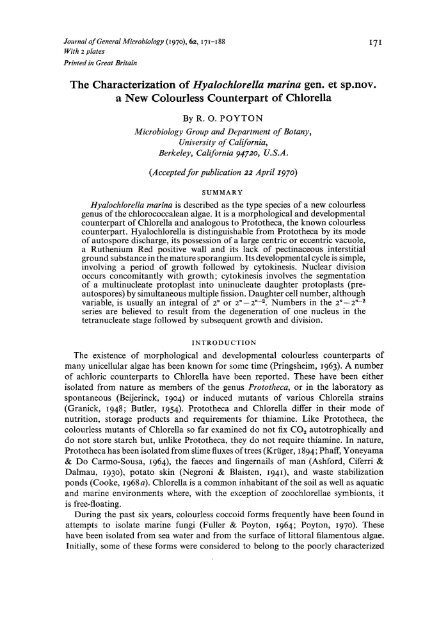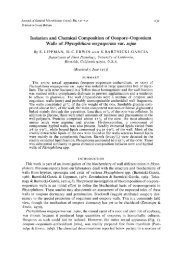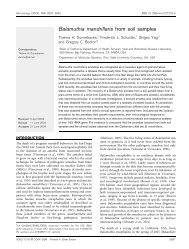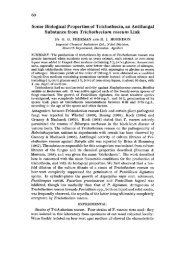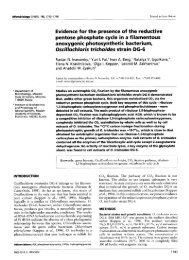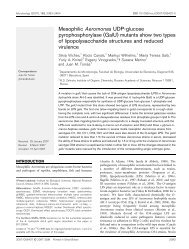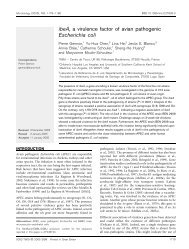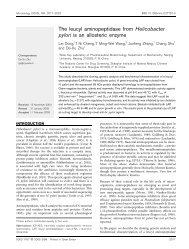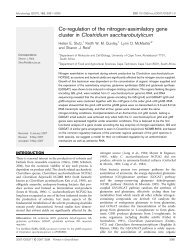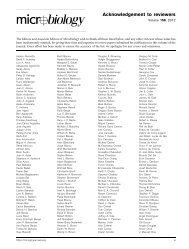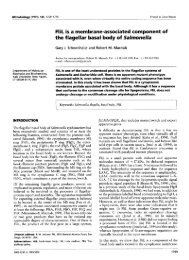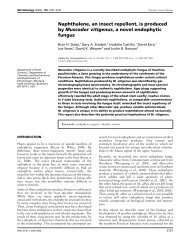The Characterization of Hyalochlorella marina gen. et ... - Microbiology
The Characterization of Hyalochlorella marina gen. et ... - Microbiology
The Characterization of Hyalochlorella marina gen. et ... - Microbiology
You also want an ePaper? Increase the reach of your titles
YUMPU automatically turns print PDFs into web optimized ePapers that Google loves.
Journal <strong>of</strong> General <strong>Microbiology</strong> (1970), 62, 171-188<br />
With 2 plates<br />
Printed in Great Britain<br />
<strong>The</strong> <strong>Characterization</strong> <strong>of</strong> <strong>Hyalochlorella</strong> <strong>marina</strong> <strong>gen</strong>. <strong>et</strong> sp.nov.<br />
a New Colourless Counterpart <strong>of</strong> Chlorella<br />
By R. 0. POYTON<br />
<strong>Microbiology</strong> Group and Department <strong>of</strong> Botany,<br />
University <strong>of</strong> California,<br />
Berkeley, California 94720, U.S.A.<br />
(Accepted for publication 22 April r970)<br />
SUMMARY<br />
<strong>Hyalochlorella</strong> <strong>marina</strong> is described as the type species <strong>of</strong> a new colourless<br />
<strong>gen</strong>us <strong>of</strong> the chlorococcalean algae. It is a morphological and developmental<br />
counterpart <strong>of</strong> Chlorella and analogous to Prototheca, the known colourless<br />
counterpart. <strong>Hyalochlorella</strong> is distinguishable from Prototheca by its mode<br />
<strong>of</strong> autospore discharge, its possession <strong>of</strong> a large centric or eccentric vacuole,<br />
a Ruthenium Red positive wall and its lack <strong>of</strong> pectinaceous interstitial<br />
ground substance in the mature sporangium. Its developmental cycle is simple,<br />
involving a period <strong>of</strong> growth followed by cytokinesis. Nuclear division<br />
occurs concomitantly with growth; cytokinesis involves the segmentation<br />
<strong>of</strong> a multinucleate protoplast into uninucleate daughter protoplasts (pre-<br />
autospores) by simultaneous multiple fission. Daughter cell number, although<br />
variable, is usually an integral <strong>of</strong> 2" or 2n-2n-2. Numbers in the 2fl-2n-z<br />
series are believed to result from the de<strong>gen</strong>eration <strong>of</strong> one nucleus in the<br />
t<strong>et</strong>ranucleate stage followed by subsequent growth and division.<br />
INTRODUCTION<br />
=7=<br />
'<strong>The</strong> existence <strong>of</strong> morphological and developmental colourless counterparts <strong>of</strong><br />
many unicellular algae has been known for some time (Pringsheim, 1963). A number<br />
<strong>of</strong> achloric counterparts to Chlorella have been reported. <strong>The</strong>se have been either<br />
isolated from nature as members <strong>of</strong> the <strong>gen</strong>us Prototheca, or in the laboratory as<br />
spontaneous (Beijerinck, 1904) or induced mutants <strong>of</strong> various Chlorella strains<br />
(Granick, 1948; Butler, 1954). Prototheca and Chlorella differ in their mode <strong>of</strong><br />
nutrition, storage products and requirements for thiamine. Like Prototheca, the<br />
colourless mutants <strong>of</strong> Chlorella so far examined do not fix COz autotrophically and<br />
do not store starch but, unlike Prototheca, they do not require thiamine. In nature,<br />
Prototheca has been isolated from slime fluxes <strong>of</strong> trees (Kriiger, 1894; Phaff, Yoneyama<br />
& Do Carmo-Sousa, 1964), the faeces and fingernails <strong>of</strong> man (Ashford, Ciferri &<br />
Dalmau, 1930), potato skin (Negroni & Blaisten, 1941), and waste stabilization<br />
ponds (Cooke, 1968a). Chlorella is a common inhabitant <strong>of</strong> the soil as well as aquatic<br />
and marine environments where, with the exception <strong>of</strong> zoochlorellae symbionts, it<br />
is free-floating.<br />
During the past six years, colourless coccoid forms frequently have been found in<br />
attempts to isolate marine fungi (Fuller & Poyton, 1964; Poyton, 1970). <strong>The</strong>se<br />
have been isolated from sea water and from the surface <strong>of</strong> littoral filamentous algae.<br />
Initially, some <strong>of</strong> these forms were considered to belong to the poorly characterized
= 72 R. 0. POYTON<br />
protistan <strong>gen</strong>us, Dermocystidium (Fuller & Poyton, 1964; Goldstein & Moriber,<br />
1966). Recently, however, a closer look at the developmental cycle and morphology<br />
<strong>of</strong> these forms has led to the conclusion that they are morphological and develop-<br />
mental counterparts <strong>of</strong> Chlorella, y<strong>et</strong> distinct from Prototheca, its known colourless<br />
counterpart. <strong>The</strong> following work was undertaken to characterize these forms more<br />
fully and to d<strong>et</strong>ermine the extent to which they differed from Prototheca.<br />
METHODS<br />
Organisms. <strong>The</strong> source and date <strong>of</strong> isolation for each strain assigned to <strong>Hyalochlorella</strong><br />
<strong>marina</strong> are listed in Table I. Strains 66-6~ and 69-1 A have been deposited<br />
in the Indiana University Algal Culture Collection. <strong>The</strong> following strains <strong>of</strong> the<br />
<strong>gen</strong>us Prototheca were used for comparative studies with H. <strong>marina</strong>.<br />
68-I~A P. zopfii strain ~ ~ 8 <strong>of</strong> 3 3 the Northern Utilization and Developmental<br />
Laboratory. Received from Indiana University Culture Collection as strain I 438.<br />
68-I~A P. zopfii strain 263/5 <strong>of</strong> the Cambridge University Algal Culture Collection.<br />
Received from Indiana University Algal Culture Collection as strain 328.<br />
68-I~A P. zopJi strain 1~7300 <strong>of</strong> the Hopkin’s Marine Station. Received from<br />
Dr C. B. van Niel.<br />
68-I~A P. zopfii strain 1~7322 <strong>of</strong> the Hopkin’s Marine Station. Received from<br />
Dr C. B. van Niel.<br />
68-I~A P. zopfii strain 1~7321 <strong>of</strong> the Hopkin’s Marine Station. Received from<br />
Dr C. B. van Niel.<br />
68-1 8 A P. chlorelloides strain 263/1 <strong>of</strong> the Cambridge University Algal Culture<br />
Collection. Received from the Indiana University Algal Culture Collection as<br />
strain 178.<br />
68-I~A P. chlorelloides strain 1v731 I <strong>of</strong> the Hopkin’s Marine Station. Received<br />
from Dr C. B. van Niel.<br />
68-20~ P. pastoriensis strain 1~7342 <strong>of</strong> the Hopkin’s Marine Station. Received<br />
from Dr C. B. van Niel.<br />
68-21 A P. pastoriensis strain 1~7341 <strong>of</strong> the Hopkin’s Marine Station. Received<br />
from Dr C. B. van Niel.<br />
68-22~ P. stagnora strain 62-344 <strong>of</strong> Dr W. B. Cooke. Received from the Indiana<br />
University Algal Culture Collection as strain 1442.<br />
68-23~ P. moriformis strain 263/2 <strong>of</strong> the Cambridge University Algal Culture<br />
Collection. Received from the Indiana University Algal Culture Collection as strain<br />
288.<br />
68-24~ P. wickerhamii strain ~ ~4330 <strong>of</strong> the Northern Utilization and Development<br />
Laboratory. Received from the Indiana University Algal Culture Collecti.on<br />
as strain 1553.<br />
68-25~ P. portoricensis strain 1075 <strong>of</strong> Dr B. K. Ashford. Received from the<br />
Indiana University Algal Culture Collection as strain 289.<br />
68-26~ P. portoricensis var. triporus strain 1095 <strong>of</strong> Dr B. K. Ashford. Received<br />
from the Indiana University Algal Culture Collection as strain 327.<br />
68-27~ Prototheca sp. strain 1~7361 <strong>of</strong> the Hopkin’s Marine Station. Received<br />
from Dr C. B. van Niel.<br />
68-28~ Prototheca sp. strain 1~7351 <strong>of</strong> the Hopkin’s Marine Station. Received<br />
from Dr C. B. van Niel.
<strong>Characterization</strong> <strong>of</strong> <strong>Hyalochlorella</strong> <strong>marina</strong> =73<br />
68-29~ Prototheca sp. strain 1~7371 <strong>of</strong> the Hopkin’s Marine Station. Received<br />
from Dr C. B. van Niel.<br />
Three spontaneous colourless mutants <strong>of</strong> Chlorella sp. were also used in comparative<br />
studies with <strong>Hyalochlorella</strong> <strong>marina</strong> ; 69-7~, 69-8 A, 69-9 A derived from Chlorella<br />
sp. strain 820 <strong>of</strong> the Indiana University Algal Culture Collection.<br />
Table I. Sources <strong>of</strong> <strong>Hyalochlorella</strong> isolates<br />
Strain Date isolated Source<br />
M<strong>et</strong>hod<br />
<strong>of</strong> isolation*<br />
66-5 B<br />
September 1965 Ceramium rubrum filament,<br />
Newport, Rhode Island<br />
IA<br />
66-6~<br />
July 1965 Polysiphonia sp. filament,<br />
Newport, Rhode Island<br />
I<br />
66-8 A<br />
September I 965 Ceramium rubrum filament,<br />
Newport, Rhode Island<br />
IA<br />
68-30~<br />
H. <strong>marina</strong> strain w ~49 <strong>of</strong> Dr H. Vishniac. Received from<br />
Dr S. Goldstein as Dermocystidiurn sp. Isolated from coastal<br />
waters near Wood’s Hole, Massachus<strong>et</strong>ts. ATCC I 6323.<br />
68-3 I A<br />
H. <strong>marina</strong> strain ~1s37 <strong>of</strong> Dr S. Goldstein. Received from<br />
American Type Culture Collection as Dermocystidiurn sp. Isolated<br />
from coastal waters near Bayville, New York. ATCC 16324.<br />
69-1 A<br />
May 1969 Endocladia sp. filament,<br />
Moss Beach, California<br />
IA<br />
69-2 A June 1969 Endocladia sp. filament,<br />
Moss Beach, California<br />
I<br />
69-3 A June 1969 Phyllospadix sp. blade,<br />
Moss Beach, California<br />
IA<br />
69-4 A June 1969 Polysiphonia sp. filament,<br />
Moss Beach, California<br />
I<br />
69-5 A May 1969 Gelidium sp. filament,<br />
Moss Beach, California<br />
I<br />
69-6 A June 1969 Sea water,<br />
Moss Beach, California<br />
I1<br />
* Numbers listed refer to those given by Poyton (1970).<br />
Isolation and maintenance <strong>of</strong> organisms. Strains <strong>of</strong> <strong>Hyalochlorella</strong> <strong>marina</strong> were<br />
isolated as described by Poyton (1970). <strong>The</strong> m<strong>et</strong>hod used is indicated in Table I.<br />
Clones <strong>of</strong> each isolate were established from daughter organisms (autospores) either<br />
by successive transfer <strong>of</strong> single colonies or by micromanipulation using a de Fronbrume<br />
micromanipulator. Stock cultures were maintained on moist gelatin hydrolysate-<br />
dextrose-yeast extract (GDY) agar slants composed <strong>of</strong> ( % w/v) : gelatin hydrolysate<br />
(enzymic, Nutritional Biochemicals Co.) 0-<br />
I ; dextrose, 0-<br />
I ; yeast extract (Difco),<br />
0.01 ; Noble agar (Difco), 1-2; sea water adjusted to a salinity <strong>of</strong> 33x0 with a Beckman<br />
RB3 Soh-Bridge. Slants were incubated at 20 to 22’ and transferred every 5 to 6<br />
weeks. Prototheca strains were cloned and incubated as described above. Stock<br />
cultures were maintained on slants <strong>of</strong> malt extract agar (Difco) and transferred<br />
every 6 to 8 weeks.<br />
On receipt <strong>of</strong> Chlorella sp. strain 820 it was cloned as above and maintained under<br />
the same conditions as <strong>Hyalochlorella</strong>, except that it was incubated under continuous<br />
light <strong>of</strong> low intensity (4000 lux). Spontaneous colourless mutants were isolated by
=74 R. 0. POYTON<br />
inoculating a GDY agar plate with a dense suspension <strong>of</strong> Chlorella sp. and incubating<br />
it in the dark. After I week, occasional large creamy white colonies were observed.<br />
<strong>The</strong>se were streaked on GDY plates and incubated in continuous light (4000 lux)<br />
to insure that they were not reversible mutants. Each mutant was cloned and maintained<br />
under the same conditions as <strong>Hyalochlorella</strong>.<br />
Growth conditions. Liquid cultures were incubated at 20" on a rotary shaker at<br />
200 rev./min. in either 125 ml. Erlenmeyer flasks, with sidearms which fit a Kl<strong>et</strong>t-<br />
Summerson colorim<strong>et</strong>er, containing 25 ml. medium or in 20 ml. screw-cap test tubes<br />
containing 5 to 10 ml. medium. Turbidity in the culture flasks was measured with<br />
a Kl<strong>et</strong>t-Summerson colorim<strong>et</strong>er using a blue (c. 420 nm.) filter. Standard curves<br />
relating dry weight to Kl<strong>et</strong>t units were established for representative strains and<br />
turbidity d<strong>et</strong>erminations were taken on or corrected to the linear portion <strong>of</strong> these<br />
curves.<br />
Anaerobic incubations were done in a Torbal jar containing 94 "/o (v/v) H, and<br />
6 % (v/v) CO,; residual oxy<strong>gen</strong> was removed by including platinum-coated alumina<br />
pell<strong>et</strong>s (Heller, 1954). Two m<strong>et</strong>hylene blue indicators <strong>of</strong> anaerobiosis were used. One<br />
was made up as described by Meynell & Meynell (1965) and the other was an<br />
Anaerobic Indicator (Baltimore Biological Laboratory). Both were <strong>gen</strong>erally colour-<br />
less within 6 h. after adding the gas mixture. <strong>The</strong> test medium was GDY with<br />
0.6 % (w/v) dextrose.<br />
Cell cycle analysis. <strong>The</strong> relationships b<strong>et</strong>ween growth and nuclear and cell division<br />
were studied in two ways. In the first, the growth <strong>of</strong> single organisms was followed<br />
microscopically in a microperfusion chamber (Poyton & Branton, 1970) s<strong>et</strong> up for<br />
either gas or liquid perfusion. For liquid perfusion, medium was aerated by sparging<br />
with sterile air just before being fed through the chamber at I ml./min. Organisms<br />
were kept stationary by the Cellophane-strip technique previously referred to by<br />
Poyton & Branton (1970). For gas perfusion, the top coverslip <strong>of</strong> the chamber was<br />
coated with a very thin layer <strong>of</strong> GDY agar as described by Skerman (1967) and<br />
inoculated. Humidified sterile air at 20' was passed through the chamber.<br />
For the second approach, distributions <strong>of</strong> organism volumes were compared with<br />
distributions <strong>of</strong> the numbers <strong>of</strong> nuclei per organism. Volumes were d<strong>et</strong>ermined with<br />
a Coulter Counter model B (Coulter Electronics, Inc., Hialeah, Florida) equipped<br />
with a IOO pm. aperture and a Size Distribution Plotter model J. Paper mulberry pollen<br />
was used for volume calibrations; all counts were corrected for background counts<br />
in the diluent. Nuclei were stained by the Feul<strong>gen</strong> m<strong>et</strong>hod as follows. Samples from<br />
a culture growing exponentially in GDY medium were centrifuged at 2000g for<br />
10 min. to give a pell<strong>et</strong> <strong>of</strong> 0.005 to 0.02 ml. <strong>The</strong> organisms were washed once with<br />
distilled water, fixed in Carnoy's ac<strong>et</strong>ic acid-alcohol for 10 min. (Bakerspigel, 1957)<br />
and then taken through the procedure <strong>of</strong> Tamiya, Morimura, Yokota & Kunieda<br />
(1961) or Bakerspigel (1957). <strong>The</strong> Schiff rea<strong>gen</strong>t was made according to Leuchten-<br />
berger (1958). Fixed organisms were hydrolysed in I N-HCl at 60" for 5, 10, 15 and<br />
20 min. Optimal staining occurred after 15 min. hydrolysis with the m<strong>et</strong>hod <strong>of</strong><br />
Tamiya <strong>et</strong> al. (1961) and after 10 min. hydrolysis with the m<strong>et</strong>hod <strong>of</strong> Bakerspigel<br />
(1957). At the end <strong>of</strong> the Feul<strong>gen</strong> staining procedure, organisms were mounted in ac<strong>et</strong>o-<br />
carmine as described by McIntosh (1954). To d<strong>et</strong>ermine that nuclei were specifically<br />
stained by these procedures, two controls were routinely run: (I) organisms were<br />
exposed to 0.02 % (w/v) deoxyribonuclease as described by Jensen (1962) and (2)
<strong>Characterization</strong> <strong>of</strong> <strong>Hyalochlorella</strong> <strong>marina</strong> I75<br />
the HCl hydrolysis step was omitted. No stained bodies were seen in either<br />
control,<br />
Variation in number <strong>of</strong> autospores. <strong>The</strong> number <strong>of</strong> daughters (autospores) produced<br />
per mother (sporangium) was d<strong>et</strong>ermined by observing microcolony development on<br />
slides coated with GDY agar (Skerman, 1967). Agar-coated slides were stored on the<br />
surface <strong>of</strong> a GDY agar P<strong>et</strong>ri plate at 4" until needed. <strong>The</strong>y were inoculated at 20"<br />
from early exponential phase GDY liquid cultures and incubated 40 to 48 h. Sporangial<br />
bursts were scored microscopically either immediately after incubation or after<br />
storage at 4" for no more than 10 h.<br />
Cytological observations. Cellulose in the wall was d<strong>et</strong>ermined by the zinc-chlor-<br />
iodide m<strong>et</strong>hod <strong>of</strong> Rawlins & Takahashi (1952) and the IKI-H,S04 m<strong>et</strong>hod <strong>of</strong> Johansen<br />
(1940). Pectic wall substances were d<strong>et</strong>ected by the Ruthenium Red m<strong>et</strong>hod as<br />
described by Kessler & Soeder (1962). Capsules and gelatinous matrices surrounding<br />
organisms were d<strong>et</strong>ermined by negative staining in indian ink. Exponentially<br />
growing cells from a vari<strong>et</strong>y <strong>of</strong> media were tested.<br />
<strong>The</strong> presence and localization <strong>of</strong> intracellular starch was d<strong>et</strong>ermined by making<br />
w<strong>et</strong> mounts <strong>of</strong> both fixed and unfixed organisms in IKI. <strong>Hyalochlorella</strong> and spontaneous<br />
colourless mutants <strong>of</strong> Chlorella were fixed in Carnoy's ac<strong>et</strong>ic acid-alcohol ; Prototheca<br />
was fixed in 10 % (v/v) formalin. In all cases, fixed and unfixed organisms gave similar<br />
results. Intracellular lipid granules were stained with Sudan Black as described by<br />
Burdon (1946). Organisms were taken from exponential and stationary phase cultures<br />
grown on GDY agar and GDY agar plus 2 % (wfv) glucose.<br />
Vacuoles and refractile granules in exponentially growing cells were observed in<br />
w<strong>et</strong> mounts by phase contrast microscopy.<br />
Photomicrography. All photomicrographs except P1. I, fig. 2 were taken on<br />
Adox KB14 35 mm. film through a Leitz Ortholux microscope equipped with<br />
apochromatic phase contrast objectives and a Heine condenser. For P1. I, fig. 2,<br />
Ultropak achromatic objectives with ring condensers were used and dark-field<br />
reflected light illumination was provided by an Ultropak illuminator.<br />
Production <strong>of</strong> extracelhlar enzymes. Extracellular enzymes were sought by replica<br />
plating (Lederberg & Lederberg, 1952) as described by Stanier, Palleroni & Doudor<strong>of</strong>f<br />
(1966). A s<strong>et</strong> <strong>of</strong> master plates were prepared on GDY medium rehydrated with tap<br />
water for Prototheca strains and with sea water for <strong>Hyalochlorella</strong> strains and colour-<br />
less mutants <strong>of</strong> Chlorella. <strong>The</strong>y were patched with 15 strains and incubated for I week.<br />
One master plate served to print 12 test plates.<br />
Extracellular gelatinase production was d<strong>et</strong>ermined as described by Skerman<br />
(1967): gelatin, 5 % (wlv), was added to yeast extract (Difco), 0.5 % (w/v); K,HPO,,<br />
0.1 % (w/v); MgS0,.7H20, 0.02 % (w/v); Ionagar (Oxoid), 1.0 % (w/v); tap water<br />
or sea water. Each strain was replicated in duplicate. One s<strong>et</strong> was flooded with<br />
acidic mercuric chloride after 5 days and the other after 10 days <strong>of</strong> incubation. Only<br />
strains which showed a clear zone extending beyond the limits <strong>of</strong> growth were scored<br />
as positive. Gelatin liquefaction was assessed in 12-8 % (w/v) Difco nutrient gelatin.<br />
<strong>The</strong> stab was examined for liquefaction periodically over 2 weeks.<br />
Extracellular lipase was d<strong>et</strong>ermined by the m<strong>et</strong>hod <strong>of</strong> Sierra (1957). After sterilization,<br />
the peptone medium was supplemented with I % (w/v) polyoxy<strong>et</strong>hylene (20) sorbitan<br />
mono-oleate (Tween 80) and the pH was adjusted to 7-2. Observations were made<br />
over 8 days.<br />
I2 MIC 62
176 R. 0. POYTON<br />
Starch hydrolysis was d<strong>et</strong>ermined in agar and liquid GDY containing 0.2 % (w/v)<br />
soluble starch in place <strong>of</strong> dextrose. After 8 days, the plates were flooded with Lugol's<br />
iodine solution (Soci<strong>et</strong>y <strong>of</strong> American Bacteriologists, 1957) and observed for colourless<br />
areas beneath and around the patches <strong>of</strong> growth. Starch hydrolysis in liquid medium<br />
was d<strong>et</strong>ermined by adding one drop <strong>of</strong> Lugol's iodine solution to small aliquots<br />
withdrawn after 5 and 10 days and comparing the colour with an uninoculated medium<br />
control.<br />
Alginate digestion was d<strong>et</strong>ermined by a modification <strong>of</strong> the m<strong>et</strong>hod described by<br />
Skerman (1967). Agar plates <strong>of</strong> two layers were made: 1.0 % (w/v) sodium alginate<br />
(Sigma) and 1-6 % (w/v) Noble agar (Difco) on top <strong>of</strong> GDY agar minus dextrose<br />
(GY agar), both rehydrated with tap water or sea water. Plates were examined over<br />
14 days. Tap water plates were flooded with I % (w/v) CaCl,. 2H,O and scored for<br />
a clear zone around the colonies. Sea water plates were scored for clarification<br />
directly.<br />
<strong>The</strong> hydrolysis <strong>of</strong> agar was d<strong>et</strong>ermined by growing organisms on the surface <strong>of</strong><br />
GY agar. Evaporation from these plates was minimized by incubating them in<br />
plastic bags. Plates were observed over 20 days for agar s<strong>of</strong>tening around each patch<br />
<strong>of</strong> growth.<br />
Growth in complex media. Growth and colony morphology were assessed on<br />
a vari<strong>et</strong>y <strong>of</strong> complex media rehydrated with distilled water or sea water. <strong>The</strong>se<br />
were: 3.0 % (w/v) Difco fluid thioglycollate medium with 1-4 % (w/v) Difco Noble<br />
agar; 4.0 % (w/v) Difco Emerson YpSs agar; 2-3 % (w/v) Difco nutrient agar; GDY<br />
agar supplemented with 2.0 % (w/v) dextrose; 2.0 % (w/v) Difco peptone supplemented<br />
with 0-2 % (w/v) dextrose plus 1-2 % (wlv) Difco Noble agar; and 3 % (w/v) Difco<br />
malt extract plus 1-2 % (w/v) Difco Noble agar. Growth was recorded after 7 and<br />
10 days as + (good growth), & (poor growth but b<strong>et</strong>ter than control plate <strong>of</strong> GDY<br />
agar without dextrose), - (no more growth than on control plate).<br />
Miscellaneous tests. Catalase production was d<strong>et</strong>ermined by the evolution <strong>of</strong><br />
O2 bubbles from cell smears flooded with 3 % (v/v) HzOz.<br />
Clumping <strong>of</strong> newly discharged autospores was scored directly by microscopic<br />
observation and indirectly by scoring for cellular clumps in agitated GDY liquid<br />
medium and for a pellicle in unagitated GDY medium. Both tests were run on<br />
organisms incubated in 10 ml. medium in 20 ml. test tubes. In agitated medium,<br />
large clumps <strong>of</strong> organisms resulted from the aggregation <strong>of</strong> clumped autospores<br />
around air bubbles. <strong>The</strong> pellicle formed in unagitated medium resulted partly from<br />
this aggregation and partly from the surface tension properties <strong>of</strong> autospore clumps.<br />
<strong>The</strong> pellicle <strong>gen</strong>erally represented 5 to 10 % <strong>of</strong> the total count. <strong>The</strong> remaining go to<br />
95 % <strong>of</strong> the organisms formed a pell<strong>et</strong>. All cultures were scored after 4 to 6 days.<br />
Wall strength was arbitrarily measured as susceptibility or resistance to sonication<br />
and freeze-thawing. Exponentially growing organisms were used in both tests. <strong>The</strong>y<br />
were washed once with distilled water, centrifuged at 4" for 10 min. at 20008,<br />
resuspended in distilled water and treated for 10 min. at oo with a 10 kc. Ratheon<br />
sonic oscillator. For freeze-thawing, the organisms were washed once with distilled<br />
water, collected by centrifugation and rapidly frozen to -20'. After 24 h. they<br />
were rapidly thawed to 37". Wall breakage by both m<strong>et</strong>hods was assessed micro-<br />
scopically.
<strong>Characterization</strong> <strong>of</strong> <strong>Hyalochlorella</strong> <strong>marina</strong> =77<br />
RESULTS<br />
Morphological observations and developmental cycle analysis<br />
HyalochZorella <strong>marina</strong> individuals were colourless and produced creamy, yeast-like<br />
colonies on agar medium. On GDY agar the colonies were convex and <strong>gen</strong>erally<br />
smooth-margined (PI. I, fig. I) under a dissecting microscope. However, in some<br />
strains, older colonies (12 to 20 days) developed ‘watery’ edges (Pl. I, fig. 3) which<br />
resulted from the degradation <strong>of</strong> peripherally located organisms. As the colony<br />
grew older, the ‘watery’ region proceeded toward the colony centre, and at the end<br />
<strong>of</strong> about 25 days the colony was devoid <strong>of</strong> spherical cells. Wh<strong>et</strong>her this degradation<br />
was due to lysis or to synctium formation is uncertain, but the presence <strong>of</strong> walls<br />
radiating out from the colony centre into the ‘watery’ region seems to rule out<br />
lysis. Attempts to subculture pieces <strong>of</strong> the ‘watery’ edge were unsuccessful. In all<br />
strains, colonies with irregular haloes (Pl. I , fig. 2) were observed, but with an incidence<br />
<strong>of</strong> less than 0.5 %. <strong>The</strong>se haloes were formed by motile preautospores which migrated<br />
from the colony and subsequently became encased by a wall. This will be discussed in<br />
more d<strong>et</strong>ail below.<br />
One <strong>of</strong> the difficulties in the taxonomy <strong>of</strong> simple chlorococcalean algae such as<br />
Chlorella and Prototheca is their paucity <strong>of</strong> distinguishing morphological charac-<br />
teristics. <strong>The</strong> two characteristics which have been used in previous considerations <strong>of</strong><br />
Prototheca are size and shape (Pringsheim, 1963; Cooke, 1968b). Often, in giving<br />
size, authors have failed to specify which developmental stage was measured. Since<br />
sporangial size is directly related to the number <strong>of</strong> autospores produced and since<br />
the developmental stages b<strong>et</strong>ween the autospore and sporangium can be only<br />
temporarily distinguished, the only stage for which size d<strong>et</strong>erminations were felt<br />
valuable in this study was the newly discharged autospore. Measurements <strong>of</strong> 500<br />
newly discharged autospores <strong>of</strong> each strain growing exponentially on GDY liquid<br />
and agar medium showed a range in diam<strong>et</strong>er <strong>of</strong> 4 to 6.5 pm. and a mean diam<strong>et</strong>er<br />
<strong>of</strong> 5-5 pm. Immature sporangium diam<strong>et</strong>ers varied from 7 to 25 pm.; the smaller<br />
sporangia produced 2 autospores and the larger sporangia up to 128 autospores.<br />
<strong>The</strong> cell shape is spherical and occasionally ovoidal.<br />
<strong>The</strong> developmental cycle discussed below is based mostly on studies with strain<br />
66-6~, the type culture, and strains 66-5~, 66-8~, 68-30~ and 68-31~. Asexual<br />
reproduction took place by autospore formation. Following emer<strong>gen</strong>ce <strong>of</strong> the<br />
uninucleate autospore, the developmental cycle (Pl. 2 & Fig. I ) involved the immediate<br />
formation <strong>of</strong> a centric or eccentric vacuole followed by an increase in size with<br />
a concomitant increase in the number <strong>of</strong> nuclei by nuclear division. <strong>The</strong> immature<br />
sporangium was spherical and multinucleate. Cytokinesis occurred by multiple<br />
fission during which the multinucleate protoplast <strong>of</strong> the immature sporangium was<br />
segmented simultaneously into uninucleate protoplasts. Segmentation begins by<br />
invagination <strong>of</strong> the peripheral protoplast and central vacuole membranes ; both<br />
light microscope and electron microscope studies (Burr, unpublished work) showed<br />
the sporangial wall was not in any way involved. <strong>The</strong> uninucleate daughter protoplast<br />
(preautospore), devoid <strong>of</strong> a wall, was capable <strong>of</strong> motility similar to that <strong>of</strong> limax<br />
amoebae (Pl. I, fig. 12 to 14). As mentioned above, a small percentage <strong>of</strong> the colonies<br />
on each plate formed these motile preautospores. This percentage was greatly increased<br />
12-2
178 R. 0. POYTON<br />
by incubating the plates at 4" for 24 h. or at low O2 tension (2.1 % v/v 0,). <strong>The</strong>se<br />
forms could also be seen by squashing an immature sporangium. Next in the develop-<br />
mental cycle, the preautospores formed a wall and were liberated from the sporangium<br />
by irregular lateral rupture <strong>of</strong> the sporangial wall. Autospores were sequentially<br />
discharged and were compl<strong>et</strong>ely free from one another. In stationary phase cultures,<br />
occasionally not all <strong>of</strong> the autospores emerged from the sporangium and som<strong>et</strong>imes<br />
none emerged, giving rise to a structure which appeared to be a sorus <strong>of</strong> sporangia.<br />
Throughout the entire developmental cycle the wall (Pl. I, fig. 10) was smooth and<br />
thin. It did not thicken with age, but did become more apparent in mature sporangia<br />
because spaces developed b<strong>et</strong>ween it and the enclosed autospores. At no stage did<br />
a capsule or gelatinous matrix surround the organism.<br />
D<br />
Fig. I. Semidiagrammatic drawing <strong>of</strong> the developmental cycle <strong>of</strong><br />
<strong>Hyalochlorella</strong> <strong>marina</strong>. x I 300.<br />
Nuclear division. Preliminary microscopic observations indicated a correlation<br />
b<strong>et</strong>ween nuclear number and size <strong>of</strong> organism. Organisms <strong>of</strong> immature sporangial<br />
size were never seen with only one or two nuclei and organisms <strong>of</strong> autospore size<br />
did not contain more than one nucleus. This suggested that nuclear division occurred<br />
concomitantly with growth rather than after the growth period, just before cyto-<br />
kinesis. To test this, distributions <strong>of</strong> size <strong>of</strong> individuals and numbers <strong>of</strong> nuclei per<br />
individual were compared for exponentially growing organisms (see M<strong>et</strong>hods). If<br />
nuclei divided in step with increasing volume, one would expect the distribution<br />
curves to be superimposable, whereas if nuclear division occurred just before<br />
K
<strong>Characterization</strong> <strong>of</strong> <strong>Hyalochlorella</strong> <strong>marina</strong> I79<br />
cytokinesis, one would expect the curves to be non-superimposable with a high<br />
narrow peak in nuclear distribution at one nucleus. <strong>The</strong> distribution curves were<br />
roughly superimposable (Fig. 2), indicating that nuclear division did indeed accompany<br />
growth.<br />
Table 2. Spore number variation in <strong>Hyalochlorella</strong> <strong>marina</strong><br />
Number <strong>of</strong> mother cells<br />
Strains<br />
Number <strong>of</strong> autospores I h -l<br />
released 66-5 B 66-6 A 68-30 A 68-31 A<br />
2<br />
4<br />
6<br />
8<br />
I2<br />
16<br />
24<br />
32<br />
48<br />
64<br />
I 28<br />
Numbers b<strong>et</strong>ween 2 and 128<br />
not specifically noted above<br />
(incompl<strong>et</strong>e cleavage)<br />
2<br />
4<br />
23<br />
19<br />
32<br />
-<br />
I02<br />
36<br />
32<br />
5<br />
-<br />
5<br />
5<br />
57<br />
6<br />
I93<br />
62<br />
I7<br />
3<br />
I5<br />
2<br />
I5<br />
-<br />
79<br />
4<br />
187<br />
Total number <strong>of</strong> mother cells 250 350 350 3 50<br />
Percentage organisms giving<br />
2n spores<br />
78 92 82.3 98.8<br />
Percentage organisms giving 9.2 3-1 13'4 1'2<br />
2n - 2n-2 spores<br />
Percentage organisms giving I 2.8 4'9 4'3 0<br />
incompl<strong>et</strong>e cleavage numbers<br />
Due to the small size <strong>of</strong> nuclei in <strong>Hyalochlorella</strong> it was rather difficult to d<strong>et</strong>ermine<br />
its mode <strong>of</strong> nuclear division. Phase contrast microscopy <strong>of</strong> living organisms as well<br />
as observations <strong>of</strong> Feul<strong>gen</strong> ac<strong>et</strong>ocarmine stained organisms indicated that nuclear<br />
division took place by mitosis within the nuclear membrane. Enlarged nuclei lacking<br />
nucleoli were <strong>of</strong>ten seen in living immature sporangia (Pl. 2, fig. IS). Stained organisms<br />
<strong>of</strong> all developmental stages possessed oblong and elongated nuclear division figures<br />
which stained most densely at their ends. <strong>The</strong> dense staining was presumably due to<br />
chromosomal material.<br />
<strong>The</strong> relation <strong>of</strong> nuclear division to growth and cytokinesis is summarized in Fig. I.<br />
All <strong>of</strong> the nuclei within a multinucleate organism divided simultaneously. This is<br />
based on observations that the nuclear number per cell was usually an integral <strong>of</strong><br />
2n and that when division figures were observed all <strong>of</strong> the nuclei in the cell possessed<br />
them.<br />
Variation in spore number. Variation in the number <strong>of</strong> daughters produced per<br />
mother is a characteristic that most organisms which undergo asexual cytokinesis<br />
by simultaneous multiple fission have in common. Data for four representative<br />
strains <strong>of</strong> <strong>Hyalochlorella</strong> are given in Table 2. To eliminate the possibility that<br />
organisms in a cluster arose from more than one sporangium, only those bursts<br />
were scored which showed one sporangial wall and in which all <strong>of</strong> the daughters<br />
were approximately the same size (Pl. I, fig. 4 to 9). In exponentially growing cultures<br />
57<br />
6<br />
0
180 R. 0. POYTON<br />
the number <strong>of</strong> daughters was usually 2n where n is I to 7. Daughter numbers <strong>of</strong><br />
2% - 2n-2 (n = 2 to 6) occurred with varying frequencies. This sequence was apparently<br />
initiated by the de<strong>gen</strong>eration <strong>of</strong> one nucleus at the four nucleate stage (Fig. IB) and<br />
the division <strong>of</strong> the organism into three uninucleate protoplasts (PI. I, fig. 11).<br />
Subsequent growth and division occurred normally to give 2n - 2n-2 daughters<br />
(Fig. IB-H, B-I, B-J, B-K). Another source <strong>of</strong> variation from the 2n number <strong>of</strong><br />
daughters was incompl<strong>et</strong>e cleavage <strong>of</strong> the sporangium. <strong>The</strong> clusters resulting from<br />
these sporangial bursts were easily recognized by the presence <strong>of</strong> daughters <strong>of</strong> variable<br />
size. While most <strong>of</strong> the daughters were <strong>of</strong> normal volume, some were twice this<br />
volume. Daughter numbers <strong>of</strong> 14, 26, 28 and 56 were <strong>of</strong>ten recorded. <strong>The</strong> frequency<br />
<strong>of</strong> incompl<strong>et</strong>e cleavage in each strain varied but was usually less than 5 %. It was<br />
lowest in exponential phase cultures and increased in the stationary phase.<br />
In view <strong>of</strong> the wide variation in number <strong>of</strong> daughters and its dependence on culture<br />
conditions (Goldstein & Moriber, 1966; R. 0. Poyton, unpublished), the number<br />
<strong>of</strong> autospores produced per sporangium has been ruled out as a means <strong>of</strong> distinguishing<br />
species within the <strong>gen</strong>us <strong>Hyalochlorella</strong>.<br />
Physiological and biological characteristics. Initial comparisons <strong>of</strong> <strong>Hyalochlorella</strong><br />
and Prototheca indicated that the two <strong>gen</strong>era had similar morphologies and identical<br />
developmental cycles but differed in the thickness <strong>of</strong> their walls, the presence <strong>of</strong><br />
a large centric or eccentric vacuole in <strong>Hyalochlorella</strong> and the clumping <strong>of</strong> autospores<br />
during and after discharge in Prototheca. To seek more distinguishing characteristics,<br />
the tests in Table 3 were made on several strains <strong>of</strong> both <strong>gen</strong>era. With the exception<br />
<strong>of</strong> slight extracellular amylase activity for strain 69-3 and variable growth on thioglycollate<br />
agar, there was no variation among the 11 strains <strong>of</strong> H. <strong>marina</strong>. Among<br />
the 17 strains <strong>of</strong> Prototheca there was a great deal <strong>of</strong> variation in colony morphology<br />
on thioglycollate agar and in the thickness <strong>of</strong> the pellicle formed on GDY medium.<br />
Otherwise, except for morphological differences and differences in size which have<br />
been previously noted (Tubaki & Soneda, 1959 ; Pringsheim, 1963; Cooke, 1968b),<br />
there was little variation. <strong>The</strong> three colourless Chlorella strains studied showed no<br />
variation at all.<br />
Characteristics <strong>of</strong> <strong>Hyalochlorella</strong>, Prototheca, Chlorella and colourless mutants<br />
<strong>of</strong> Chlorella are listed in Table 4. <strong>The</strong>se organisms have in common similar shapes<br />
and size, cytokinesis via multiple fission, and walls <strong>of</strong> high tensile strength. In<br />
each <strong>gen</strong>us, the number <strong>of</strong> autospores produced per sporangium varies, usually<br />
being an integral <strong>of</strong> 2n. An infrequent developmental pathway gives 2n - 2n-2 autospores<br />
per sporangium. As described above, this occurs in <strong>Hyalochlorella</strong> due to<br />
the de<strong>gen</strong>eration <strong>of</strong> one nucleus <strong>of</strong> a t<strong>et</strong>ranucleate cell (Fig. I, A-B-K). A similar<br />
developmental sequence has been inferred from counts <strong>of</strong> the number <strong>of</strong> daughter<br />
cells <strong>of</strong> P. zopJii in which it occurs with a frequency <strong>of</strong> less than 5 % (R. 0. Poyton, unpublished<br />
work). Although this developmental pathway is not well documented in<br />
Chlorella, there are data listing autospore number per sporangium in which numbers<br />
in the series 2n-2n-2 do occur (Murakami, Morimura & Takamiya, 1963; Kuhl<br />
& Lorenzen, 1964). Perhaps some <strong>of</strong> the t<strong>et</strong>rads <strong>of</strong> spores commonly figured for<br />
Chlorella (e.g. Resigl, 1964) are actually triads like that pictured in P1. I, fig. I I.<br />
<strong>The</strong> existence <strong>of</strong> motile preautospores in <strong>Hyalochlorella</strong> is at the moment considered<br />
a useful characteristic for differentiating it from Prototheca. Similar structures have<br />
also been reported for Chlorella (R6tovskg & KlriSterskB, 1961). Perhaps the reason
<strong>Characterization</strong> <strong>of</strong> <strong>Hyalochlorella</strong> <strong>marina</strong> I81<br />
why Prototheca does not exhibit these forms is that the pectinaceous matrix in<br />
which autospores and preautospores lie inhibits cell movement. Another possible<br />
explanation is that the wall <strong>of</strong> Prototheca is more resistant to breakage than that <strong>of</strong><br />
<strong>Hyalochlorella</strong> and thus prevents the emer<strong>gen</strong>ce <strong>of</strong> preautospores. <strong>The</strong> sporangial<br />
wall <strong>of</strong> Prototheca is 0-1 to 0.2 pm. thick (Lloyd & Turner, 1968), about three times<br />
that <strong>of</strong> <strong>Hyalochlorella</strong> walls. Differences in wall composition may also be implicated.<br />
<strong>The</strong> pectinaceous ground substance surrounding autospores in the mature<br />
Table 4. Some characteristics <strong>of</strong> Chlorella and its colourless counterparts*<br />
Cell morphology :<br />
Shape<br />
Autospore size<br />
Central vacuole<br />
Refractile granules<br />
Development :<br />
Motile preautospores<br />
Autospores clumped on discharge<br />
Variable autospore number<br />
Autospore numbers <strong>of</strong> 2n - 2n-2<br />
Pectinaceous ground substance in<br />
mature sporangium<br />
Pellicle formation<br />
Storage products :<br />
Fat<br />
Carbohydrate<br />
Intracellular carbohydrate storage :<br />
Pyrenoid<br />
Granules<br />
Dispersed<br />
Anaerobic growth<br />
Catalase activity<br />
Walls :<br />
Resistant to freeze- t haw<br />
Resistant to sonification<br />
Contain cellulose<br />
Contain pectin<br />
Growth on:<br />
YpSs agar<br />
Ma1 t agar<br />
Extracellular enzymes :<br />
Amylase<br />
Gelatinase<br />
Agarase<br />
Lipase<br />
Alginase<br />
HyalochIorella Prototheca<br />
Spherical,<br />
ovoidal,<br />
ellipsoidal<br />
2-10 ,urn.<br />
-<br />
+<br />
-<br />
+<br />
+<br />
-<br />
+<br />
-<br />
+<br />
-<br />
-<br />
+<br />
+<br />
-<br />
-<br />
+<br />
-<br />
-<br />
-<br />
-<br />
-<br />
Chlorella<br />
(colourless<br />
mutants)<br />
Spherical<br />
2-4 pm.<br />
-<br />
+<br />
+<br />
-<br />
-<br />
-<br />
+<br />
-<br />
-<br />
+<br />
-<br />
+<br />
+<br />
-<br />
-<br />
+<br />
-<br />
-<br />
-<br />
Chlorella<br />
Spherical<br />
ovoidal<br />
2-8 pm.<br />
vt<br />
V<br />
* Data for <strong>Hyalochlorella</strong>, Prototheca and colourless mutants <strong>of</strong> Chlorella come from Table 3.<br />
Data for Chlorella were compiled from Fritsch, 1948; Northcote, Goulding & Horne, 1958;<br />
Murakami, Morimura & Takamiya, 1963; Soeder, 1963; Kuhl & Lorenzen, 1964.<br />
t v = Variable.<br />
+<br />
V<br />
+<br />
-<br />
-<br />
?<br />
+<br />
+<br />
-<br />
-<br />
-<br />
+<br />
+<br />
V<br />
?<br />
?<br />
?<br />
V<br />
?<br />
?<br />
?
182 R. 0. POYTON<br />
sporangium is another useful means <strong>of</strong> distinguishing <strong>Hyalochlorella</strong> from Prototheca.<br />
It was first noticed in Prototheca by electron microscopy (Menke & Fricke, 1962)<br />
and in my study it was demonstrated with Ruthenium Red. Light and electron<br />
microscopy (F. Burr, unpublished work) show no such matrix in <strong>Hyalochlorella</strong>. It<br />
seems very likely that the clumping <strong>of</strong> newly discharged autospores in Prototheca<br />
can be accounted for by the presence <strong>of</strong> this matrix around cells before, during<br />
and immediately after discharge.<br />
rt" 40-<br />
30<br />
20<br />
lo<br />
- ,'<br />
I<br />
/<br />
I<br />
-;<br />
I<br />
I<br />
7<br />
-<br />
\ $<br />
\ \<br />
\<br />
t 1 ' I I I I I I I I<br />
60 120 180 240 300 360 420 480 540<br />
Cell volume (p3)<br />
J I I I I I I I I I<br />
1 2 3 4 5 6 7 8<br />
Nuclear number/organism<br />
Fig. 2. Distributions <strong>of</strong> sizes and nuclear numbers for HyalochloreZEa <strong>marina</strong>. Strain 66-6~<br />
was grown to mid-exponential phase on GDY medium supplemented with 0.6 yo gelatin<br />
hydrolysate. Size (--) was d<strong>et</strong>ermined for organisms suspended in sea water <strong>of</strong> salinity<br />
33x0. <strong>The</strong> total number <strong>of</strong> organisms measured was 15,180. Nuclear number/organism<br />
(@ - - - @) was d<strong>et</strong>ermined for a total <strong>of</strong> 300. Strains 66-5 B, 68-30~ and 68-31 A gave<br />
similar curves.<br />
<strong>Hyalochlorella</strong> also differs from Prototheca in its lack <strong>of</strong> refractile granules (pre-<br />
sumably carbohydrate), its possession <strong>of</strong> a large vacuole and an extracellular lipase,<br />
its inability to grow on YpSs agar, malt agar and GDY medium rehydrated with<br />
tap water, and its accumulation <strong>of</strong> fat as well as carbohydrate. Fats are collected<br />
as large dropl<strong>et</strong>s in both exponential and stationary phase cultures <strong>of</strong> <strong>Hyalochlorella</strong> ;<br />
polysaccharides are dispersed throughout the cytoplasm. <strong>The</strong> amount stored per<br />
organism increases greatly when the glucose in the growth medium is raised to 2 to<br />
3 % (w/v). <strong>The</strong> exact nature <strong>of</strong> the polysaccharides is at the moment uncertain; the<br />
red-brown coloration given with IKI is quite different from the blue-black colour<br />
given by starch, which suggests that the polysaccharide products in <strong>Hyalochlorella</strong>,<br />
Prototheca and the colourless strains <strong>of</strong> Chlorella are <strong>of</strong> relatively short chain length.
<strong>Characterization</strong> <strong>of</strong> <strong>Hyalochlorella</strong> <strong>marina</strong> 183<br />
Requirements for a marine environment. All strains <strong>of</strong> <strong>Hyalochlorella</strong> so far isolated<br />
fit the criteria defining a marine bacterium (MacLeod, 1965). Unlike the species <strong>of</strong><br />
Prototheca listed above, HyalochZoreZla <strong>marina</strong> grew only on isolation plates rehydrated<br />
with sea water.<br />
Time (h.)<br />
Fig. 3. Kin<strong>et</strong>ics <strong>of</strong> death <strong>of</strong> <strong>Hyalochlorella</strong> <strong>marina</strong> 66-6~ in distilled water media. Organisms<br />
were incubated at zoo in distilled water (O-), GDY medium rehydrated with distilled<br />
water (0-0), sea water (U-U) and GDY medium rehydrated with sea water (0-0).<br />
Samples were taken at various time intervals and plated on GDY medium for viable<br />
count d<strong>et</strong>erminations. Similar curves were obtained for strains 66-8 A, 68-30~ and<br />
68-31 A.<br />
<strong>The</strong> dry weight yield in GDY medium with 0.6 % (wlv) gelatin hydrolysate increased<br />
linearly from o with sea water salinities b<strong>et</strong>ween o to 23x0, was constant in the range<br />
23 to 40%~ and decreased in salinities exceeding 40%~. Swelling and death occurred<br />
in media <strong>of</strong> low osmotic pressure. Populations incubated in distilled water at 20°<br />
usually exhibited a diphasic death curve (Fig. 3). For strain 66-6~ the first phase<br />
lasted for 80 to go h. and practically no loss <strong>of</strong> viability occurred. In the second<br />
phase the death rate was 0-12 h.-l. <strong>The</strong> death rate was two to three times less for<br />
organisms in GDY medium. Control cultures incubated in sea water or GDY<br />
medium rehydrated with sea water increased in viable count to a value which remained<br />
constant. No evidence for cell-wall thickening as a means <strong>of</strong> resistance to high or<br />
low osmotic pressure has ever been obtained.
184 R. 0. POYTON<br />
DISCUSSION<br />
<strong>The</strong> taxonomic position <strong>of</strong> <strong>Hyalochlorella</strong> is subject to the same consideration as<br />
its analogue Prototheca. Generally, Prototheca has been considered to be a nonpigmented<br />
counterpart <strong>of</strong> Chlorella (West, 1916; Fritsch, 1948). However, some<br />
authors have favoured a taxonomic position closer to the fungi (Kruger, 1894;<br />
Saccardo & Traverso, 1911; Tubaki & Soneda, 1959). Lloyd & Turner (1968)<br />
concluded from its wall composition that it probably is not an achloric counterpart<br />
<strong>of</strong> Chlorella. Attempts to relate Prototheca to the fungi have relied almost entirely<br />
on the morphology <strong>of</strong> the mature sporangium, which resembles the asci <strong>of</strong> many<br />
ascomyc<strong>et</strong>es and the spherules <strong>of</strong> some fungi <strong>of</strong> uncertain affinities. In these attempts,<br />
development and sporo<strong>gen</strong>esis have been largely ignored.<br />
In ascomyc<strong>et</strong>es, ascospore formation is preceded by conjugation and takes place<br />
by free cell formation. Spore initials are formed within the ascal cytoplasm and out<br />
<strong>of</strong> contact with the mother cell plasmalemma (Madelin, 1966). <strong>The</strong> formation <strong>of</strong><br />
sporangia in Prototheca and <strong>Hyalochlorella</strong> is not preceded by conjugation and the<br />
mother cell plasmalemma plays an active role during spore delimitation, eventually<br />
becoming part <strong>of</strong> the daughter cell plasmalemma. In view <strong>of</strong> these developmental<br />
differences it is unlikely that Prototheca and <strong>Hyalochlorella</strong> are close relatives <strong>of</strong> the<br />
ascomyc<strong>et</strong>es.<br />
One fungus which has a mode <strong>of</strong> spore formation similar to that <strong>of</strong> <strong>Hyalochlorella</strong><br />
is Coccidioides, a dermatophyte <strong>of</strong> uncertain affinities. <strong>The</strong> endospore and spherule<br />
<strong>of</strong> Coccidioides are analogous to the autospore and mature sporangium <strong>of</strong> <strong>Hyalochlorella</strong>.<br />
Although sporo<strong>gen</strong>esis in both <strong>gen</strong>era occurs by multiple fission (Tarb<strong>et</strong>,<br />
Wright & Newcomer, I 952), Coccidioides differs from <strong>Hyalochlorella</strong> in the active<br />
role which the sgorangial wall plays in sporo<strong>gen</strong>esis (O’Hern & Henry, 1956;<br />
Breslau, Hensley & Erickson, 1961), the uneven thickening <strong>of</strong> the newly discharged<br />
endospore wall (Moore, 1965), and the production <strong>of</strong> a mycelial culture phase<br />
(Baker, Mrak & Smith, 1943). Moreover, during endospore formation in Coccidioides<br />
the mother cell wall is contiguous with the daughter wall and on spore discharge no<br />
sporangial wall is left behind. In <strong>Hyalochlorella</strong> the mother cell wall is not contiguous<br />
with the daughter cell wall and is left behind intact on spore discharge. <strong>The</strong>se<br />
differences seem sufficient to rule out any taxonomic relatedness <strong>of</strong> these two<br />
<strong>gen</strong>era.<br />
A preliminary study <strong>of</strong> strains 68-30~ and 68-~IA lead Goldstein & Moriber<br />
(1966) to characterize them tentatively as marine fungi <strong>of</strong> the poorly defined <strong>gen</strong>us<br />
Dermocystidium. This has aroused interest in the relationship b<strong>et</strong>ween these strains<br />
and the other members <strong>of</strong> the <strong>gen</strong>us, for they would represent the only members <strong>of</strong><br />
the <strong>gen</strong>us whose compl<strong>et</strong>e development has been studied in pure axenic culture.<br />
Goldstein & Moriber’s (1966) assignation <strong>of</strong> these strains to the <strong>gen</strong>us Dermocystidium<br />
was based on their <strong>gen</strong>eral morphology and possession <strong>of</strong> a refrin<strong>gen</strong>t vacuolar<br />
inclusion (vacuoplast), considered to be an important feature <strong>of</strong> the <strong>gen</strong>us Dermocystidium<br />
(Perez, 1907 ; Mackin, 1962). <strong>The</strong> paucity <strong>of</strong> morphological features makes<br />
it extremely difficult to distinguish these strains from some other micro-organisms,<br />
<strong>The</strong>refore a heavy reliance must be placed on developmental and physiological<br />
characteristics. Perkins (I 969) has shown that veg<strong>et</strong>ative cleavage in Dermocystidium<br />
marinurn, the best characterized member <strong>of</strong> the <strong>gen</strong>us, yields endospores with unevenly
<strong>Characterization</strong> <strong>of</strong> <strong>Hyalochlorella</strong> <strong>marina</strong> 185<br />
thickened walls by a series <strong>of</strong> events similar to those described above for Coccidioides.<br />
This developmental sequence is quite different from that reported by Goldstein &<br />
Moriber (1966) for their strains. In the above study I have been unable to confirm<br />
two <strong>of</strong> the observations reported by Goldstein & Moriber (1966). <strong>The</strong> vacuoplast is<br />
present only in stationary phase cultures and never in exponentially growing cells;<br />
when present, it occurs in less than 0-01 % <strong>of</strong> the developing sporangia and can<br />
therefore hardly be considered typical. I have also been unable to confirm their<br />
inference that growth is accompanied by the periodic liberation <strong>of</strong> individuals from<br />
their walls by ecdysis. During the compl<strong>et</strong>e development <strong>of</strong> single individuals (PI. 2),<br />
the only stage during which a wall is shed is at autospore liberation.<br />
<strong>The</strong> infrequent appearance <strong>of</strong> a vacuoplast, the possession <strong>of</strong> a mode <strong>of</strong> veg<strong>et</strong>ative<br />
cleavage different from that found in Derrnocystidium marinum, and the morphological<br />
and developmental similarities to Prototheca lead me to believe that these strains<br />
should not be placed in the <strong>gen</strong>us Derrnocystidium and to erect the new algal <strong>gen</strong>us<br />
Hy aloch lor ella.<br />
On the basis <strong>of</strong> morphology and development, <strong>Hyalochlorella</strong> is a colourless<br />
counterpart <strong>of</strong> the alga Chlorella and analogous to Prototheca. In addition to its<br />
mode <strong>of</strong> sporo<strong>gen</strong>esis, features it has in common with Chlorella are motile preauto-<br />
spores, variable numbers <strong>of</strong> autospores, and walls <strong>of</strong> high tensile strength. Hyalo-<br />
chlorella differs from Prototheca in discharging autospores sequentially and separately<br />
rather than as a clump, in lacking a pectinaceous ground substances in the mature<br />
sporangium, in possessing a large vacuole in all developmental stages except for the<br />
autospore and mature sporangium, and in the wall reaction with Ruthenium Red.<br />
All <strong>Hyalochlorella</strong> <strong>marina</strong> strains give a pectin positive reaction <strong>of</strong> variable in-<br />
tensity, whereas all strains <strong>of</strong> Prototheca give a negative reaction. Some Chlorella<br />
species give a positive Ruthenium Red reaction <strong>of</strong> varying intensity and some a<br />
negative reaction (Kessler & Soeder, I 962). Possibly, Prototheca is more closely<br />
related to the Ruthenium Red negative strains and <strong>Hyalochlorella</strong> to the Ruthenium<br />
Red positive strains.<br />
Hyachlorella <strong>marina</strong> <strong>gen</strong>. <strong>et</strong> sp.nov.<br />
Cellulae sine colore, in agaro nutriente colonias cremias fermentoideasque, margini-<br />
bus plerumque levibus, efficientes. Cellulae veg<strong>et</strong>ativae iuvenes (autosporea) uninucle-<br />
atae, membranam tenuem habentes, sphericae ad ovoideas, 4 ad 6.5 pm. diam.<br />
Reproductio asexualis per formationem autosporarum effecta. Crescentia formationem<br />
vacuolae eccentricae magnae implicat, deinde cellula crescit, simul nucleus se dividit.<br />
Sporangium immaturum sphericum, 7 ad 25 pm. diam., multinucleatum. Cytokinesis<br />
per fissionem multiplicem ad 2, 4, 8, 16, 32, 64, 128 vel 3, 6, 12, 24, 48 autosporas<br />
uninucleatas in omni sporangio formandas effecta. Autosporae ruptura laterali mem-<br />
branae sporangii liberatae. Protoplasti mobiles emer<strong>gen</strong>tes interdum observati.<br />
Omnes autosporae in culturis in periodo crescentiae immobili interdum e sporangio<br />
non emergunt ; aliquando nullae autosporae emergunt, ut sorum sporangiorum<br />
efficiatur. Membrana cellulae levis tenuisque, senescens non spissescens. Matrix gela-<br />
tinosa membranam circumdans nulla. Cellulae in cultura liquida non se cohaerentes.<br />
Reproductio sexualis non observata.<br />
<strong>The</strong> author expresses his appreciation to Dr D. Branton, Dr M. S. Fuller and<br />
Dr J. A. West for their interest and helpful suggestions during this study. He would
186 R. 0. POYTON<br />
also like to thank Dr C. B. van Niel and Dr S. Goldstein for the strains which they<br />
contributed, Dr D. Branton for the use <strong>of</strong> his Leitz Ortholux microscope, Dr L. Packer<br />
for the use <strong>of</strong> his Coulter Counter and Dr H. Croasdale for the Latin translation<br />
This work was supported by a N.A.S.A. Grant (NsG(T)-117-2).<br />
REFERENCES<br />
ASHFORD, B. K., CIFERFU, R. & DALMAU, L. M. (1930). A new species <strong>of</strong> Prototheca and a vari<strong>et</strong>y <strong>of</strong><br />
the same isolated from the human intestine. Archiv fur Protistenkunde 70, 619-638.<br />
BAKER, E. E., MRAK, E. M. & SMITH, C. E. (1943). <strong>The</strong> morphology, taxonomy, and distribution<br />
<strong>of</strong> Coccidioides immitis Rixford and Gilchrist I 896. Farlowia I, 199-244.<br />
BAKERSPIGEL A., (1957). <strong>The</strong> structure and mode <strong>of</strong> division <strong>of</strong> the nuclei in the yeast cells and<br />
mycelium <strong>of</strong> Blastomyces dermatitidis. Canadian Journal <strong>of</strong> <strong>Microbiology</strong> 3, 923-936.<br />
BEIJERINCK, M. W. (1904). Chlorella variegata, ein bunter Mikrobe. Recueil des Travaux Botaniques<br />
Neerlandais I, 14-27.<br />
BRESLAU, A. M., HENSLEY, T. J. & ERICKSON, J. 0. (1961). Electron microscopy <strong>of</strong> cultured spherules<br />
<strong>of</strong> Coccidioides immitis. Journal <strong>of</strong> Biophysical and Biochemical Cytology 9, 627-637.<br />
BURDON, K. L. (1946). Fatty material in bacteria and fungi revealed by staining dried, fixed slide<br />
preparations. Journal <strong>of</strong> Bacteriology 52, 665-678.<br />
BUTLER, E. E. (1954). Radiation-induced chlorophyll-less mutants <strong>of</strong> Chlorella. Science, New York<br />
120, 274-275.<br />
COOKE, W. B. (1968a). Studies in the <strong>gen</strong>us Prototheca. I. Literature review. Journal <strong>of</strong> the Elisha<br />
Mitchell Scientific Soci<strong>et</strong>y 84, 2 I 3-2 I 6.<br />
COOKE, W. B. (1968 b). Studies in the <strong>gen</strong>us Prototheca. 11. Taxonomy. Journal <strong>of</strong> the Elisha Mitchell<br />
Scientijic Soci<strong>et</strong>y 84, 2 I 7-220.<br />
DAVIES, R. R., SPENCER, H. & WAKELIN, P. 0. (1964). A case <strong>of</strong> human Protothecosis. Transactions<br />
<strong>of</strong> the Royal Soci<strong>et</strong>y <strong>of</strong> Tropical Medicine and Hygiene 58, 448-451.<br />
FRITSCH, F. E. (1948). <strong>The</strong> Structure and Reproduction <strong>of</strong> the Algae, vol. I. Cambridge University<br />
Press.<br />
FULLER, M. S. & POYTON, R. 0. (1964). A new technique for the isolation <strong>of</strong> aquatic fungi. Bioscience<br />
14,45-46.<br />
GOLDSTEIN, S. & MORIBER, L. (1966). Biology <strong>of</strong> a problematic marine fungus, Dermocystidium sp.<br />
I. Development and cytology. Archiv fiir Mikrobiologie 53, 1-1 I.<br />
GRANICK, S. (1948). Protoporphyrin 9 as a precursor <strong>of</strong> chlorophyll. Journal <strong>of</strong> Biological Chemistry<br />
172, 717-727.<br />
HELLER, C. L. (1954). A simple m<strong>et</strong>hod for producing anaerobiosis. Journal <strong>of</strong> Applied Bacteriology<br />
17, 202.<br />
JENSEN, W. A. (1962). Botanical Histochemistry, p. 252. San Francisco: W. H. Freeman and Co.<br />
JOHANSEN, D. A. (1940). Plant Microtechnique. New York : McGraw-Hill.<br />
KESSLER, E. & SOEDER, C. J. (1962). Biochemical contributions to the taxonomy <strong>of</strong> the <strong>gen</strong>us Chlorella.<br />
Nature, London 194, 1096-1097.<br />
KRUGER, W. (I 894). Kurze Characteristik einiger niederer Organismen in Saftflussen der Laubbaume.<br />
I. Ueber einen neuen Pilz-Typus, reprasentiert durch die Gattung Prototheca. (P. moriformis (sic)<br />
<strong>et</strong> P. zopjii). Hedwigia 33, 241-25.<br />
KUHL, A. & LORENZEN, H. (1964). Handling and culturing <strong>of</strong> Chlorella. In M<strong>et</strong>hods in Cell Physiology,<br />
vol. I, pp. 159-187. Edited by D. M. Prescott. New York: Academic Press.<br />
LEDERBERG, J. & LEDERBERG, E. M. (1952). Replica plating and indirect selection <strong>of</strong> bacterial mutants.<br />
Journal <strong>of</strong> Bacteriology 63, 399-406.<br />
LEUCHTENBERGER, C. (1958). Quantitative d<strong>et</strong>ermination <strong>of</strong> DNA in cells by Feul<strong>gen</strong> microspectrophotom<strong>et</strong>ry.<br />
In General Cytochemical M<strong>et</strong>hods, vol. I, pp. 219-278. Edited by J. G. Danielli.<br />
New York: Academic Press.<br />
LLOYD, D. & TURNER, G. (1968). <strong>The</strong> cell wall <strong>of</strong> Prototheca zop$i. Journal <strong>of</strong> General <strong>Microbiology</strong><br />
50Y42 1-427.<br />
MCINTOSH, D. L. (1954). A Feul<strong>gen</strong>-carmine technic for staining fungus chromosomes. StainTechnology<br />
29, 29-3 I.
<strong>Characterization</strong> <strong>of</strong> Hyalo ch lorella <strong>marina</strong> 187<br />
MACKIN, J. G. (1962). Oyster disease caused by Dermocystidium marinium and other micro-organisms<br />
in Louisiana. Publications <strong>of</strong> the Institute <strong>of</strong> Marine Sciences, University <strong>of</strong> Texas 7, 132-229.<br />
MACLEOD, R. A. (1965). <strong>The</strong> question <strong>of</strong> the existence <strong>of</strong> specific marine bacteria. Bacteriological<br />
Reviews 29, 9-23.<br />
MADELIN, M. F. (1966). <strong>The</strong> <strong>gen</strong>esis <strong>of</strong> spores <strong>of</strong> higher fungi. In <strong>The</strong> Fungus Spore. 18th Symposium<br />
<strong>of</strong> Colston Research Soci<strong>et</strong>y, pp. 15-36. London : Butterworths.<br />
MENKE, W. & FRICKE, B. (1962). Einige Beobachtun<strong>gen</strong> an Prototheca ciferri. Portugaliae Acta<br />
Biologica series A 6, 243-252.<br />
MEYNELL, G. G. & MEYNELL, E. (1965). <strong>The</strong>ory and Practice in Experimental Bacteriology, p. 74.<br />
Cambridge University Press.<br />
MOORE, R. T. (1965). <strong>The</strong> ultrastructure <strong>of</strong> fungal cells. In <strong>The</strong> Fungi, vol. I, pp. 95-118. Edited<br />
by 6. C. Ainsworth & A. S. Sussman. New York: Academic Press.<br />
MURAKAMI, S., MOWMURA, Y. & TAKAMIYA, A. (1963). Electron microscopic studies along cellular<br />
life cycle <strong>of</strong> Chlorella ellipsoidea. In Studies on Microalgae and Photosynth<strong>et</strong>ic Bacteria, pp. 65-83.<br />
Edited by J. Ashida. Tokyo: University <strong>of</strong> Tokyo Press.<br />
NEGRONI, P. & BLAISTEN, R. (1941). Estudio morfologico y fisiologico de una nueva especie de<br />
Prototheca ciferrii n. sp., aislada de epidermis de papa. Mycopathologia <strong>et</strong> Mycologia Applicata<br />
3994-104.<br />
NORTHCOTE, D. H., GOULDING, K. J. & HORNE, R. W. (1958). <strong>The</strong> chemical composition and structure<br />
<strong>of</strong> the cell wall <strong>of</strong> Chlorella pyrenoidosa. Biochemical Journal 70, 391-397.<br />
O’HERN, E. M. & HENRY, B. S. (1956). A cytological study <strong>of</strong> Coccidioides immitis by electron<br />
microscopy. Journal <strong>of</strong> Bacteriology 72, 632-645.<br />
PEREZ, C. (1907). Dermocystis pusula, organisme nouveau de la peau des tritons. Compte Rendu<br />
des Skances de la SociLtL de BioIogie 63, 445-446.<br />
PERKINS, F. 0. (1969). Ultrastructure <strong>of</strong> veg<strong>et</strong>ative stages in Labyrinthomyxa <strong>marina</strong> (= Dermocystidium<br />
marinium), a commercially significant oyster patho<strong>gen</strong>. Journal <strong>of</strong> Invertebrate<br />
Pathology 13, 199-222.<br />
PHAFF, H. J., YONEYAMA, M. & DO CARMO-SOUSA, L. (1964). A one-year, quantitative study <strong>of</strong> the<br />
yeast flora in a single slime flux <strong>of</strong> Ulmus carpinifolia Gled. Rivista di Patologia Veg<strong>et</strong>ale, Padova<br />
serie 111. 4, 485-497.<br />
POYTON, R. 0. (1970). <strong>The</strong> isolation and occurrence <strong>of</strong> <strong>Hyalochlorella</strong> <strong>marina</strong>. Journal <strong>of</strong> General<br />
<strong>Microbiology</strong> 62, 189-194.<br />
POYTON, R. 0. & BRANTON, D. (1970). A multipurpose microperfusion chamber. Experimental Cell<br />
Research 60, 109-1 14.<br />
PRINGSHEIM, E. G. (1963). Farblose Al<strong>gen</strong>. Stuttgart : Gustav Fischer Verlag.<br />
RAWLINS, T. E. & TAKAHASHI, W. N. (1952). Techniques <strong>of</strong> Plant Histochemistry and Virology.<br />
Millbrae, California: National Press.<br />
RESIGL, H. (1964). Zur Systematik und Okologie alpiner Bodenal<strong>gen</strong>. Osterreichische Botanische<br />
Zeitschrift 111, 402-499.<br />
RETOVSK+, R. & KLASTERSKA. (1961). Study <strong>of</strong> the growth and development <strong>of</strong> Chlorella populations<br />
as a whole. V. <strong>The</strong> influence <strong>of</strong> magnesium sulphate on autospore formation. Folio Microbiologica,<br />
Praha 6, I 15-126.<br />
SACCARDO, P. A. & TRAVERSO, J. B. (I91 I). Prototheca zopfii (Saccharomyc<strong>et</strong>aceae). Sylloge Fungorum<br />
20, 525.<br />
SIERRA, G. (1957). A simple m<strong>et</strong>hod for the d<strong>et</strong>ection <strong>of</strong> lipolytic activity <strong>of</strong> micro-organisms and<br />
some observations on the influence <strong>of</strong> the contact b<strong>et</strong>ween cells and fatty substances. Antonie<br />
van Leeuwenhoek 23, 15-22.<br />
SKERMAN, V. B. D. (1967). A Guide to the Genera <strong>of</strong> Bacteria, 2nd edn. Baltimore: Williams and<br />
Wilkins Co.<br />
SOCIETY OF AMERICAN BACTERIOLOGISTS. (I 957). Manual <strong>of</strong> Microbiological M<strong>et</strong>hods. Edited by<br />
Committee on Bacteriological Technic. New York : McGraw-Hill.<br />
SOEDER, C. J. (I 963). Weitere zellmorphologische und physiologische Merkmale von Chlorellaarten.<br />
In Studies <strong>of</strong> Microalgae and Photosynth<strong>et</strong>ic Bacteria. Edited by J. Ashida. pp. 21-34.<br />
Tokyo: University <strong>of</strong> Tokyo Press.<br />
STANIER, R. Y., PALLERONI, N. J. & DOUDOROFF, M. (1966). <strong>The</strong> aerobic pseudomonads: a taxonomic<br />
study. Journal <strong>of</strong> General <strong>Microbiology</strong> 43, I 59-271.
I88 R. 0. POYTON<br />
TAMIYA, H., MORIMURA, Y., YOKOTA, M. & KUNIEDA, R. (1961). Mode <strong>of</strong> nuclear division in<br />
synchronous cultures <strong>of</strong> Chlorella : comparison <strong>of</strong> various m<strong>et</strong>hods <strong>of</strong> synchronization. Plant<br />
and Cell Physiology, Tokyo 2, 383-403.<br />
TARBET, J. E., WRIGHT, E. T. & NEWCOMER, V. D. (1952). Experimental coccidioidal granuloma.<br />
Developmental stages <strong>of</strong> sporangia in mice. American Journal <strong>of</strong> Pathology 28, 901-9 17.<br />
TUBAKI, K. & SONEDA, M. (1959). Cultural and taxonomical studies on Prototheca. Nugao 6,25-33.<br />
WEST, G. S. (1916). Algae, vol. I. Cambridge University Press.<br />
EXPLANATION OF PLATES<br />
PLATE I<br />
Fig. I. Normal young colony on GDY agar. x 100.<br />
Fig. 2. Colony with irregular halo on GDY agar. x 50.<br />
Fig. 3. Edge <strong>of</strong> an old colony on GDY agar. Spherical peripheral cells have de<strong>gen</strong>erated to give<br />
a ‘watery’ edge. x 175.<br />
Fig. 4 to 9. Sporangial bursts <strong>of</strong> Hyalochlovella <strong>marina</strong> 66-6~. Note sporangial wall (S). x 500.<br />
Fig. 10. Sporangial wall. x 1400.<br />
Fig. I I, Tripartite sporangium. x 1600.<br />
Fig. 12 to 14. Motile preautospores. Five preautospores are outside <strong>of</strong> sporangial wall while two<br />
remain inside. x 1000.<br />
PLATE 2<br />
Fig. 15 to 21. Growth <strong>of</strong> an individual (<strong>Hyalochlorella</strong> <strong>marina</strong> 66-6~) under the constant environ-<br />
mental conditions <strong>of</strong> a perfusion chamber and photographed with phase contrast microscopy.<br />
x 2200. Ins<strong>et</strong>s are <strong>of</strong> Feul<strong>gen</strong>-ac<strong>et</strong>ocarmine stained cells <strong>of</strong> comparable stages. x 1400.<br />
Fig. 15. Uninucleate autospore with nucleolus (NE).<br />
Fig. 16. Binucleate stage with vacuole. Only one nucleus (NU) is obvious in the phase contrast<br />
photograph.<br />
Fig. 17. Optical section through the centre <strong>of</strong> a developing sporangium showing vacuolar centre<br />
WC).<br />
Fig. 18. Precleavage sporangium with enlarged nuclei (NU) lacking nucleoli.<br />
Fig. 19. Immature sporangium with incompl<strong>et</strong>e cleaveage lines.<br />
Fig. 20. Mature sporangium with compl<strong>et</strong>e cleavage lies (CL) delimiting preautospores.<br />
Fig 21. Ruptured sporangium and uninucleate autospores.
Journal <strong>of</strong> General <strong>Microbiology</strong>, Vol. 62, hio. 2<br />
R. 0. POYTON<br />
Plate I<br />
(Facing p. I 88)
Journal <strong>of</strong> General <strong>Microbiology</strong>, Vol. 62, No. 2 Plate 2<br />
R. 0. POYTON


